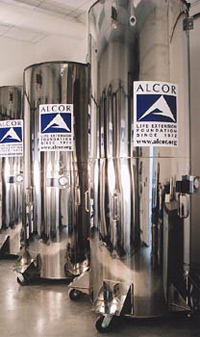Whenever big movies come out, there are tie in merchandising of all varieties – Hardees/Carl Jr’s and X-Men: Days of Future Past; Captain America: The Winter Soldier and Harley Davidson are two examples I caught this week.
But there are also unintended boosts that a movie, if popular enough, can provide. For instance – sales of archery supplies and The Hunger Games to just pick one. But for me…perhaps morbidly, I always wonder if, when a Captain America movie comes out, there’s some small bump in people showing an interest in being preserved after death via low temperatures with an eye on revival in the future. In fact, Google Trends is showing a slight bump for “cryonics” searches this month – in the absence of any major news stories about the subject. We may just be on to something here.
By the way – if you’re going to talk about it, do it right: cryonics is the method of preservation (of humans and their parts, generally) at extremely low temperatures with plans for a return to life in the future. Cryogenics is the name for the field of study that deals with extremely low temperatures (below -150 C) They may seem to play in the same ball field, but they are two different things.
It’s an ages old trope – freeze your protagonist or even antagonist and thaw them later, bingo bango – and Buck Rogers (depending on your version of choice), Philip Fry, Steve Rogers, Austin Powers, John Spartan or Simon Phoenix are up and running, good to go. It’s been a dream for a long time, suggested as a possible reality in 1962, and since time makes all technology able to do more things…we wanted to look into the Philip J. Fry route to the future a little more.
First up – yes, it’s real, yes there are companies that will do it for you – Alcor Life Extension Foundation, for one. Cryonics Institute, for another. The American Cryonics Society rounds out the three big non-profit corporations in business (with a handful of for-profit companies running). And yes, people are doing it. As of 2013 – about 270 people have opted to become…well, at worst frozen cadavers, and at best, emissaries to the future, via the deep freeze.
The thing with current technology is something that everyone is willing to admit to you up front – there’s some uncertainty about this. Current technology has no way of bringing you back. Oh, and you have to die first. Freezing people while they are still alive, even if terminal – still officially a no-no, but no one can say with absolute certainty if it’s been done among the roughly 270 believers.
What’s the big idea with cryonics? The brain. While pop culture has almost always features the body being brought back, for well over twenty years now cryonics has been largely about grabbing just the brain, either immediately after death or even well after death, but before significant deterioration or periods without oxygen, called ischemia.
In 1995, Charles Platt of Alcor pointed out advances in cryoprotectants which result in minimal damage to the brain tissue if the brain is cryogenically preserved immediately upon, or very shortly after death. The idea, according to cryonic advocates is that memory and personality are based in brain structure. Keep the brain in its living condition, at least physically, and then, at some point in the future the brain can be started up again and the person – memories intact, would be back. Assumedly in a new body…or transferred to a computer, or…something. Cryonics advocates aren’t only betting heavy on their own technology, they’re betting heavily on everyone else’s technological advances as well – the minimal damage that Platt mentioned, “can reasonably expect to be reversible at some time in the future using molecular nanotechnology.”
All the focus on the brain, of course, makes you start to think of cryopreserving loved ones in a rather different light – whole body preservation is a, well, almost a funeral, but with really, really low temperatures. Neuropreservation, or “neuro” is just the brain – usually within the head, but not always. The two camps whole body and neuro often debate which process is better. Half of the American Cryonics Society patients are neuros (it no longer offers the option), two-thirds of Alcor’s patients are neuros, while the Cryonics Institute only preserves whole bodies.
It’s easy to see the issues that can come up with the “neuro” vs. whole body options – freezing yourself for the future, and keeping yourself frozen for tens, hundreds (?) of years doesn’t come cheap – unless you’re in an iceberg in the North Atlantic. In terms of just volume, keeping a head on ice would need less energy than the body. The costs start you down the road on the side of cryonics that may keep you from one day waking up – things that have nothing to do with future medicine, but everything to do with money.
Cryopreservation will cost you. Basic costs range from $12,000 (neuro only) to $250,000 (Alcor – whole body with emergency fees included if your body happens to be overseas and your…exit was not expected). Your major costs come in when, basically your hire a group of people to come in and wait for you to die (a couple days to a week or more – and these are specialists), and the long-term storage in liquid nitrogen, which can go one for years, if not centuries. But – think a basic economics or finance class – compounding interest is your friend. Start putting a little money down for cryopreservation when you’re young, and by the time you need it, you’ll have a lump of money that will continue to work for you even after you’re been frozen. And that’s just the start.
In geek culture, cryonics hit the news last year when 23 year-old neuroscience student Kim Suozzi chose it as an option after she was diagnosed with terminal brain cancer. In a thread entitled, “Reddit, help me find some peace in dying young (I’m 23),” Suozzi explained her choice and asked for funding helpMany, including the Society for Venturism helped, and Suozzi is now in the Alcor facilities. Suozzi acknowledged the risks and her chances for returning to life, posting a quote by Dr. Ralph Merkle:
“The correct scientific answer to the question “Does cryonics work?” is: “The clinical trials are in progress. Come back in a century and we’ll give you a reliable answer.” The relevant question for those of us who don’t expect to survive that long is: “Would I rather be in the control group, or the experimental group?” We are forced by circumstances to answer that question without the benefit of knowing the results of the clinical trials.”
“Live again or die trying,” Suozzi added.
And finally for perhaps a different view (albeit with a weird Six Feet Under kind of vibe) – “We Will Live Again” has been making the rounds recently on the web. It’s a twelve-minute documentary about the dedicated people who look after individuals in cryonic storage. The short film features Ben Best and Andy Zawacki at the Cryonics Institute – which has 95 bodies – patients who are “metabolically challenged,” according to Best.
If we keep seeing more cryonic preservation stories hitting the screens, Best and company may have to make more room.
For More:










